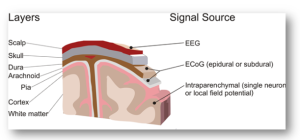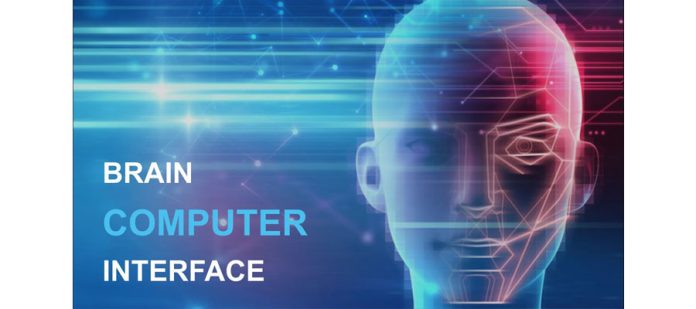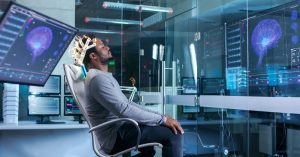Modern Computing is moving in the direction of rapid development, given the extensive research base and highly compact technological setup. The transition in neurotechnology toward more precise application potential is astounding.
Brain-Computer Interface (BCI) also known as Brain Machine Interface has driven a revolution in the area of assistive, adaptive, and rehabilitative technologies. It’s a growing field, estimated to be worth more than $1 billion globally, where the healthcare and medical sciences are known to acquire approximately 52% of this market and are expected to draw higher demand in the coming years.
Brain-Computer Interface – Explained
The primary research on Brain-Computer Interface began in 1970 in UCLA California following an attempt to establish a direct communication path between the devices (external environment) and the brain.
There are around 100 billion neurons that are responsible for our ability to think, move, feel, or work. The ions on the membrane of the neurons generate electric signals due to the difference in the electric potential carried by them. These electric signals travel from neuron to neuron at a pace of 250mph. Brain-Computer Interface captures these neural signals and decodes them into machine-level commands that instruct the device to do the intended task. In a nutshell, BCI does not use conventional neuromuscular and peripheral pathways but works on electrophysiological signals (the most advanced state of development) from the brain.
Most BCIs are experimental, but the next 20 years will extensively outline BCI in our daily lives. The few prototypes that are developed are experimented with by a few patients dealing with neurological disorders and disabilities.
Elements and Operations in Brain-Computer Interface
 In a Brain-Computer Interface system, brain signals are recorded using electrodes that are placed in one of the three areas – scalp (EEG – electroencephalogram), beneath the skull and over the cortical surface (ECoG – electrocorticography), or within the brain tissue (intracortical). These signals are further digitized to produce relevant machine commands.
In a Brain-Computer Interface system, brain signals are recorded using electrodes that are placed in one of the three areas – scalp (EEG – electroencephalogram), beneath the skull and over the cortical surface (ECoG – electrocorticography), or within the brain tissue (intracortical). These signals are further digitized to produce relevant machine commands.
Any BCI regardless of its recording methods works on six essential elements –
- Signal Acquisition
- Pre-Processing
- Feature Extraction
- Feature Classification
- Feature Translation
- Device output
Signal Acquisition – The electric potential of the brain (neurophysiological state) is measured using electrodes. The raw EEG data recorded simultaneously from multiple electrodes is not clean, attenuated by the layers it has to travel, and affected by noise from EEG equipment, electrical activity from the heart, eye blinking, muscle movements, etc. In the non-invasive approach, since the electrodes are far from the neurons and the signals have to travel through bones and the skull, the analogue signals are processed to enlarge the amplitude of the EEG signals through amplifiers, so that the signals can be interpreted and digitized accurately.
Pre-Processing – This step helps in cleaning the neurophysiological signals from noise. High-pass and low-pass filters are applied to the data to fine-tune the frequencies generated through the signals so they can be digitized.
Feature Extraction – The signals are analyzed and the ones carrying potential information are extracted. Since EEG signals are highly complex, critical processing algorithms are run on the signals to retrieve the necessary information corresponding to the user’s intent. The signal features extracted can be in the time domain or frequency domain. Some common signal features used in BCI systems are- frequency power spectra and amplitudes.
Feature Classification – Once the signal features are extracted and amplified to produce mostly clean signal data, the signal data is run under classification algorithms. Using machine learning, the classifier is trained to recognize which features are required and related to a particular class which further helps in classifying the type of mental task the subject is performing.
Feature Translation – This next step is accomplished using translation algorithms, that help in converting the retrieved signal features into machine commands that further produce the desired output of device functioning. The developed translation algorithms are dynamic and adapt to the continuous changes of the signal features and also ensure that the range of extracted signal features from the user covers the range of device control.
Device Output – As a final step, the signal features extracted and translated result into commands that operate an external device. Some possible use cases include- controlling the movement of a paralyzed arm through a neuroprosthetic, manipulating a robotic arm, communicating through a computer screen, etc.
Types of Brain-Computer Interface
 The Brain-Computer Interface output accuracy depends on the method used to capture the neurophysiological signals emitted from neurons. A BCI system does not read minds but rather acquires electrophysiological signals, analyses them, and translates them into commands which are then relayed to machines to perform the desired task. Let us look at some ways brain signals are retrieved for processing in a BCI system.
The Brain-Computer Interface output accuracy depends on the method used to capture the neurophysiological signals emitted from neurons. A BCI system does not read minds but rather acquires electrophysiological signals, analyses them, and translates them into commands which are then relayed to machines to perform the desired task. Let us look at some ways brain signals are retrieved for processing in a BCI system.
Non-invasive Brain-Computer Interface
The Non-invasive method of signal capturing works without any intrusive procedures and the user doesn’t require surgery for its placement. It works on the principle of electroencephalography (EEG) which is used to monitor and analyze brain signals. Multiple electrodes are attached to the subject’s scalp, touching the upper part of the head.
The one drawback of this method is its capability to retrieve weak signals due to low spatial resolution. The non-invasive approach has many advantages – the subject doesn’t suffer any tissue damage or scars, hence is safer, the system is easy to use and doesn’t require guidance from medical practitioners, and is portable. These factors have given researchers reasons to upgrade and advance this technology in the right direction making the non-invasive approach a more stable option for BCI systems.
Partially-Invasive Brain-Computer Interface
In the partially-invasive BCI method, electrodes are attached to the brain’s surface partially inside the head. This approach requires a small surgery and the attached electrodes monitor and capture the electrical signal from the cortex surface of the brain in electrocorticography (ECoG).
Invasive Brain-Computer Interface
Under the Invasive BCI method, the patient/user needs to undergo surgery to implant the sensors/electrodes in the brain. The invasive approach outputs a more accurate reading compared to non-invasive and partially invasive methods. While invasive BCI systems are highly efficient, they are still under evolution because the methodology can be painful and require regulatory approval before use. Proof of efficacy also requires clinical trials that are both costly and time-consuming, which becomes a bane for manufacturers.
Challenges and Limitations of Brain-Computer Interface System
All the Brain-Computer Interface systems currently under development have limitations and require efforts to set up, calibrate, and operate. EEG electrodes require a few minutes to apply but need periodic re-application and re-calibration. One major limitation is that of signal acquisition hardware. Sensors/electrodes still have acquisition limits.
The electrodes and the underlying technology need to become more reliable. EEG-based BCI must perform well in all environments. Talking specifically about home-based BCI systems- they must be compact and fit into the user’s environment seamlessly. The home-based BCI system also requires additional training for the caregiver of the user in electrode application, recognition, and correction of poor EEG signal quality. Customization of BCI according to a user’s needs should also be a readily available and feasible option.
New BCI users undergo an iterative training process. Decoding the signal feature requires months of training the models and the signals are different for different users. BCI technology as a field of application and the subject of study is still in its infancy. Research on different components of BCI development is ongoing and challenging. Dissemination of BCI systems is also a challenge since the current limited capacities of BCI systems are helpful to relatively fewer people.
By- Shilpa Shukla, Senior Editor, ELE Times









